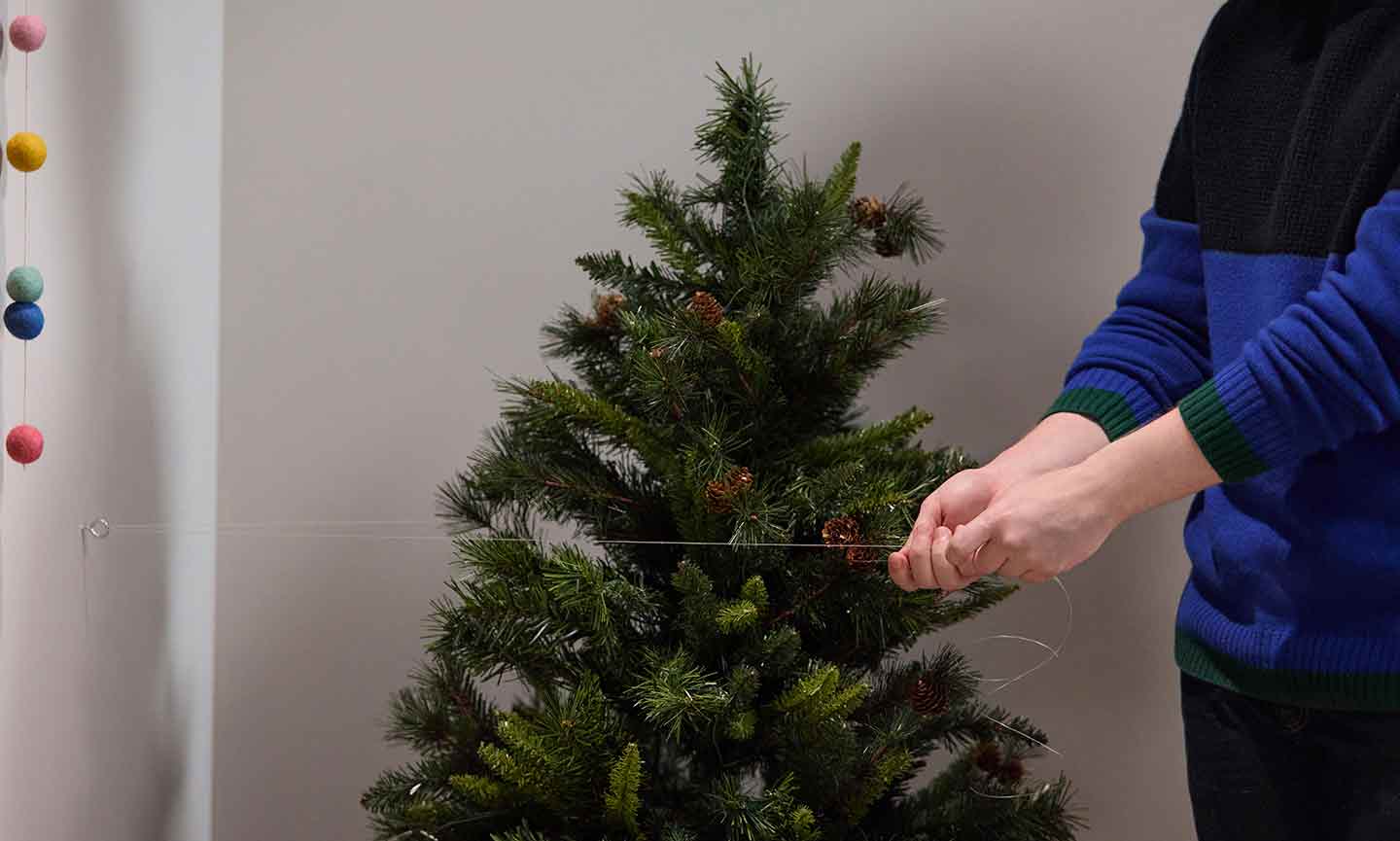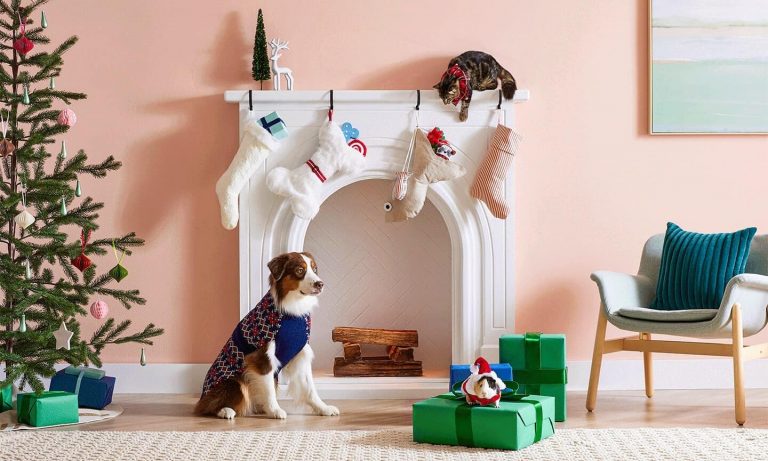Sitting under the glow of your Christmas tree—hot mug of cocoa in your hands and carols playing softly in the background—it really does feel like all is merry and bright. Until you hear the awful sound of your fragile ornaments clanking to the ground and spot your mischievous (but lovable) kitty making herself right at home in the fragrant pine needles of your decorated tree.
This is an all-too-familiar scene for cat parents, whose tree decorations and pretty holiday baubles can become toys for their feline. Even more concerning, both real and artificial Christmas trees pose a danger to our furry friends. They’re chock-full of electric wires (thanks to strung Christmas lights); ornaments that become dangerous when broken; and potential choking hazards.
Fortunately, cat-proofing your Christmas tree can help curb some of this naughty cat behavior. Keep reading to learn how to cat-proof Christmas trees so you can enjoy a month of serene and silent nights.
How to Cat-Proof Your Christmas Tree
1Consider a Safer Tree
Both artificial trees and real trees are a potential hazard to your curious cat, but some trees are technically considered safer than others.
Real Christmas trees—including popular firs and pines—are considered mildly toxic to cats when chewed or ingested. Further, tree farms sometimes use harmful pesticides on the branches. Fake trees are not as dangerous in this way, but be aware that pieces can still break off, and create a digestive blockage or choking hazard. Smaller Christmas trees are also considered less dangerous since they’re not as heavy if they topple over.
2Anchor Your Tree
Cats’ climbing instinct works well for them in the wild, where trees are firmly planted in the ground. The tree in your living room, on the other hand, can crash down much quicker.
“If you have a tree-climbing feline, your Christmas tree may topple, so make sure your tree is well secured to the ceiling or a wall,” says David Dilmore, DVM, a veterinarian at Banfield Pet Hospital in Denver.
Cristin Coll, a certified feline training and behavior specialist in Santa Monica, California, agrees. Along with anchoring the tree to the walls and ceiling with eye hooks and fishing line, she recommends a heavy and sturdy tree base.
3Choose a Safe Location
Place your Christmas tree away from anything your cat already likes to climb or perch on, such as cat trees, tall scratching posts, counters, furniture, and bookshelves. These are launch zones that allow your cat to easily jump onto your tree.
Stephen Quandt, certified feline training and behavior specialist, adds that many cats access the tree by going underneath it and climbing up. “Protecting or deterring your cat from approaching the base of the tree,” he says, “may be the best thing you can do to prevent climbing.”
If possible, keep your cat out of the room by closing the door or using a pet gate. You can also use cat deterrents to minimize your cat’s interest in the tree altogether. A barrier like Primetime Petz Configurable Gate, which comes in heights up to 3 feet tall, can help keep your feline friend away from the tree.
4Be Smart About Decorating
Anything new and shiny in your home is likely to attract your cat’s eye. But if you follow these three decorating tips, your tree might not be as interesting to your furry friend.
First, wait a few days before adding decorations to your tree. “A Christmas tree’s greatest appeal,” Quandt says, “is often when it first arrives in the home, smells nice and has cool air sinking out of it, assuming you bought it in a cold-weather environment.”
The fact that it’s a new object in the home also makes it highly appealing to curious cats. Give your furry friend time to acclimate to its presence before adding ornaments, lights or other shiny baubles.
Secondly, keep dangerous items out of reach. Climbing isn’t the only Christmas tree hazard tempting curious kitties. Dangling, breakable ornaments can also become potential playthings in the eyes of cats.
“Kittens are especially curious about new things in their environment, making your holiday decorations prime candidates for swatting, chewing and general mishaps,” Dilmore says. “Keep an eye out for glass ornaments and ornament hooks, both of which can cause puncture wounds and serious injury to probing pets.”
Other items to keep out of reach include long ribbons on Christmas presents and tinsel. Coll says that, if swallowed, ribbon can cause serious issues, including intestinal blockage and perforation of the intestinal tract.
To recap, items to keep out of reach include:
- Glass ornaments
- Metal ornament hooks
- Tiny Christmas decorations that are easily swallowed
- Fake snow (flocking), which is toxic to cats
- Tinsel
- Long ribbons
Instead, use cat-safe decorations. When dressing your tree, use decorations that won’t pose a threat to your sweet feline. Keep fragile ornaments at the tippy-top, and opt for plush ornaments on the lower branches. Instead of tinsel, use paper bows, thick cloth ribbons, or garlands made with large beads or plush materials. Anything that’s soft and won’t create a choking hazard is fair game.
Finally, give your cat an appealing tree alternative. Now’s also a great time to introduce a new toy to the mix to hopefully detract their attention from your Christmas tree.
“The only solution I have found is to give cats their own tree and reward them for playing on it,” says Samantha Bell, a cat training expert for Best Friends Animal Society. She suggests buying cats their own cat tree, or using their old one and decorating it with their toys and treats. Then, reward them whenever they interact with it, while ignoring all attempts to interact with your tree.
She says cats will realize that “their tree” is for climbing and playing, and they will soon leave your tree alone. It may sound silly, but Bell swears it works—and also provides new and exciting enrichment for your cat.
5Take Advantage of Cat Deterrents
A number of remedies can separate cats from Christmas trees, including sprays with odors cats find unpleasant, Coll says. TropiClean Chew Deterrent, for example, is designed to train cats and dogs to stay away from places they’re not allowed, like on top of the sofa, near a poisonous plant and, yes, under the Christmas tree. Another good option is YUCK! No Chew Dog, Cat & Horse Spray.
Coll adds that many cats also have aversions to textures like aluminum foil or vinyl carpet runners, so they may make ideal barriers between the cat and the tree.
6Cover Electric Cords
7Block Off the Tree Water
Cats enjoy a refreshing drink of water just like anyone else, but that’s a problem if the water’s coming from the basin beneath your Christmas tree, Dilmore says.
“If you have a live Christmas tree, make sure your cat can’t get to the water bowl underneath,” he says. “Some of the chemicals [and fertilizers] added to it to help the tree stay green can actually be toxic to pets and make them sick.”
Luckily, there are several ways to prevent your cat from drinking the tree water.
Coll recommends placing a cover over the base, or using tin foil or a tree skirt to prevent a cat from getting into the water. If blocking your cat’s access to the Christmas tree water is impossible, Dilmore recommends using fresh, clean water with no preservatives or chemical additives, and changing it daily.
8Remove Tempting Presents
Why Cats Love Christmas Trees
So why do cats love Christmas trees in the first place? Coll says that anything new—such as a Christmas tree—instantly becomes an object of curiosity.
“Most cats are very curious about Christmas trees and see them as an exciting new opportunity,” Coll says. “Christmas trees are tall; present lots of climbing, hiding and scratching spaces; and are incredibly enticing to our feline friends.”
They also appeal to cats’ innate instincts that date back before they were domesticated.
“Before cats began cohabiting with humans, trees provided a place for them to seek out their next meal and to watch over their territory,” Coll says. “As animals that are both predator and prey, being in high places like trees also provides them with a sense of safety, security and control. Cats love to feel like they are in control.”
In addition to safety concerns, there’s another instinct-driven reason to use caution around cats and Christmas trees. One of the more unpleasant—and not at all funny—risks of bringing a Christmas tree into the home is the potential of marking.
“Marking is a means of feline communication and takes on a few different forms: scratching, rubbing, urine spraying and even depositing feces, which is maddening,” Coll says. “While marking is generally considered to be an undesired behavior to cat parents, it is a completely normal cat behavior.”
In the wild, marking objects (like a tree), helps establish territories and puts out a little call for potential mates.
“The most common reasons that neutered and spayed housecats mark include territorial insecurity, other animals, stress, anxiety, and new objects with unfamiliar scents,” Coll says. “A Christmas tree would most likely fall into the category of being targeted due to unfamiliar smells.”
Understanding your own feline’s instincts and proclivities can go a long way in preventing a frustrating or potentially dangerous cat-versus-Christmas tree mishap. When you celebrate the holidays with safety in mind, every member of the family can enjoy the festive fun of the season. On that note, here are some fun ways to celebrate the holidays with your pet.
Expert input provided by Stephen Quandt, certified feline training and behavior specialist, and founder of Stephen Quandt Feline Behavior Associates, LLC; Samantha Bell, cat training expert for Best Friends Animal Society; Cristin Coll, CFTBS, CAFTP, owner of The Cat Counselor in Santa Monica, California; and David Dilmore, DVM, veterinarian at Banfield Pet Hospital in the Denver area.
More Holiday Fun
Share:































